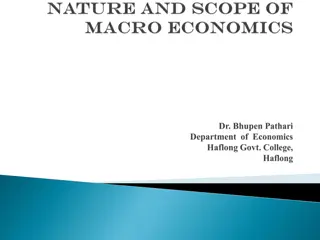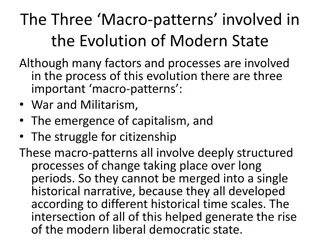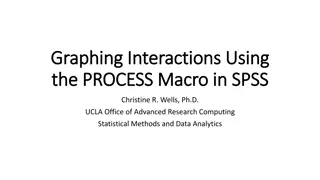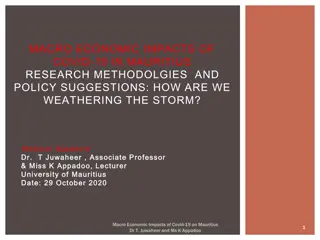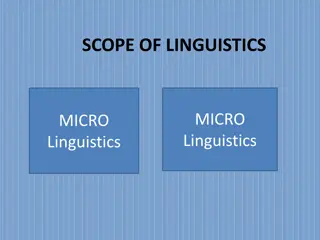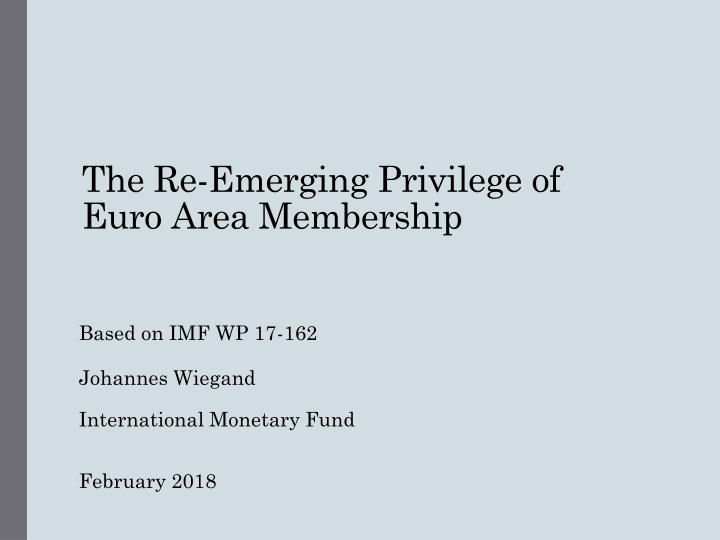
Privilege of Euro Area Membership & Its Implications
Explore the privilege associated with being a part of the Euro Area, its impact on global reserves, and academic interpretations regarding its existence post-crisis. The paper updates previous studies to provide a comprehensive view of this financial aspect.
Uploaded on | 0 Views
Download Presentation

Please find below an Image/Link to download the presentation.
The content on the website is provided AS IS for your information and personal use only. It may not be sold, licensed, or shared on other websites without obtaining consent from the author. If you encounter any issues during the download, it is possible that the publisher has removed the file from their server.
You are allowed to download the files provided on this website for personal or commercial use, subject to the condition that they are used lawfully. All files are the property of their respective owners.
The content on the website is provided AS IS for your information and personal use only. It may not be sold, licensed, or shared on other websites without obtaining consent from the author.
E N D
Presentation Transcript
The Re-Emerging Privilege of Euro Area Membership Based on IMF WP 17-162 Johannes Wiegand International Monetary Fund February 2018
Exorbitant Privilege (Valery Giscard d Estaing) USD s reserve currency status triggers higher demand for USD assets reduces funding costs and allows the US to run a wider current account deficit. Empirical evidence generally confirms existence of a USD privilege. Two methods: compare (i) the average cost of the US economy s liabilities with the average return on its assets (Gourinchas and Rey, 2007, Lane and Milesi-Ferretti 2005), or (ii) the return on US government bonds with that of peers (Maggiori, 2013) EBA: USD privilege is worth 2.7 percent of GDP.
Is a Privilege Associated with Euro Area Membership? (1) after all, creating an alternative reserve currency was one of the euro s original objectives. EBA: assigns privilege in relation to the share in global reserves euro privilege is 1/3 the size of the USD (0.9 percent of GDP for each member). Few detailed academic studies. Main exception are papers seeking to explain euro area CDS spreads before and during the euro crisis (JIMF 2013). Common finding: pre-crisis spreads were lower than what fundamentals would predict, in crisis spreads became wider.
Is a Privilege Associated with Euro Area Membership? (2) Authors give the result different interpretations: (i) de Grauwe and Yi: lack of lender of last resort for government bonds (=privilege disappeared as the crisis exposed an architectural flaw) (ii) Aizenman et al.: investors priced in expected deterioration in fundamentals (=privilege may still have been there) (iii) Gosh et al.: lack of independent monetary policy hurt in crisis (=privilege is state dependent) (iv) Beirne and Fratzscher: investors corrected their assessment of fundamentals in crisis, such as public debt (=privilege was an illusion)
Paper Updates, Refocuses and Generalizes the Earlier Studies Update: trace the evolution of privilege throughout the recovery Refocus: privilege is a longer-term concept CDS spreads are too volatile and subject to contagion to serve as a basis. Paper extracts a metric of privilege from investor assessments as revealed in risk surveys. Generalize: allow for both, investors reassessing the value of (i) euro area membership and of (ii) fundamentals during and after the euro crisis (in second part of the paper).
Basic Approach ? + ??+ ??+ ????????+ ??????+ ??? ???= ???? 1+ ??? ??: index of investor perception, 2002-16, 34 European countries, some in the euro area, some not. ?? 1: assessments are sticky investors do not reevaluate the impact of covariates every time entirely from scratch ???: vector of fundamentals Time and country fixed effects Annual dummies for euro area and EU membership. The ??measure privilege: i.e. the impact of euro area membership on investor perception, beyond what is justified by fundamentals.
Investor Perception Indices Ratings Evolution IIR Index and S&P Sovereign Credit Ratings 1 IIR (lhs) S&P (rhs) Euro area EU, not euro Outside EU 95 1 3 Evolution of Ratings, 2001-13 y = -0.228x + 22.25 R = 0.93 90 2 5 S & P Rating (linearized) 85 3 7 80 4 9 75 5 70 6 11 65 7 13 60 8 15 55 9 17 50 10 0 20 40 60 80 100 2001 2003 2005 2007 2009 2011 2013 2015 IIR Index Sources: International Investor Rating Survey, Standard and Poors, and author'scalculations.
Linear IIR Index Carries a Logical Flaw (also the S&P Index) Range is constrained Covariates marginal impact is forced to become zero as the IIR approaches the lower / upper end of its range Predicted IIR can be outside the preset numerical range Can be fixed by applying a logistic transformation: ?????100 (1 ?????) ??????= ??? 100
Logistic Transformation IIR Index and Logistic Transformation IIR Index - Kernel Density 100 100 90 90 80 80 70 70 Non- linear 60 60 IIRIndex IIRIndex 50 50 Mostly linear 40 40 30 30 20 20 10 10 Source: International Investor Ratings, -4 -2 0 0 0 2 4 0 0.01 0.02 0.03 Logaritmic IIR Index Density
Estimation Lagged dependent variables correlated with country fixed effects GMM (Arellano-Bond) Fundamentals: standard macro factors such as per capita GDP, growth, government debt, fiscal balance, NIIR, CA balance, unemployment, inflation, fixed or floating exchange rate regime, euroization Several covariates are unlikely to be strictly exogenous: shocks to current values may affect future investor perception. Instrument with lags. Results displayed in rating agency magnitudes (scaled with std. of the S&P index relative to own std.)
Core Results: Fundamentals Table 1. Basic Specifications 2002-2016 2002-2015 (1) (2) (3) (4) IIR Rating1/ S&P Rating2/ IIR Rating IIR Rating Logistic transformation1/ Logistic transformation1/ Coeff. t-value Coeff. t-value Coeff. t-value Coeff. t-value Controls Lagged perception Per-capita GDP Real growth Investment/GDP Unemployment rate CPI inflation Gen. gov. balance Gen. gov. debt External balance NIIP Euroization Floating Institutional quality Euro area membership EU membership 0.67 18.84*** 0.07 4.94*** 2.05** -2.47** -1.38 2.49** -2.38** 1.81* 3.35*** -0.62 1.53 0.60 19.00*** 1.23 2.80*** 1.67* -3.21*** -1.97** 3.88*** -3.14*** 2.14** 1.59 -0.45 1.47 0.70 15.06*** 0.73 4.41*** 0.79 -3.41*** 0.62 1.23 -0.92 2.26** 2.67*** -2.22** 0.87 0.57 16.48*** 0.67 2.84*** 1.49 -2.54** -1.43 4.46*** -3.20*** 2.70*** 1.21 -0.55 2.08** 4.44*** Figure 3 (not reported) 0.67^(-6) 8.24^(-6) 5.31^(-6) 4.60^(-6) 0.15 0.03 -0.06 -0.01 0.04 -0.01 0.03 0.003 -0.14 0.24 0.07 0.02 -0.06 -0.01 0.05 -0.01 0.03 0.001 -0.07 0.19 0.09 0.01 -0.09 0.01 0.02 -0.005 0.04 0.002 -0.39 0.13 0.07 0.02 -0.06 -0.01 0.06 -0.01 0.04 0.001 -0.09 0.26 1.81 Figure 2.1 (not reported) Figure 2.2 Figure 2.3 Figure 2.4 (not reported) Not reported: country fixed effects, time dummies, dummy for missing government debt observations. Observations 476 476 476 442 Arrelano-Bond test for autocorrelation in first-differenced errors Order 1 Order 2 -4.138 (0.000) -0.673 (0.501) -3.610 (0.000) -0.119 (0.906) -2.910 (0.004) -0.199 (0.842) -3.335 (0.001) -0.399 (0.690) 1/ Normalized with the standard deviation of the S&P rating 2/ Linearized and inverted Significance at the 1 (***), 5 (**), and 10 (*) percent level.
Core Results: Euro Premium I IIS Rating, Euro Area Membership Premium Logarithmic IIS Rating, Euro Area Membership Premium 2.5 2.5 2.0 2.0 1.5 1.5 1.0 1.0 0.5 0.5 0.0 0.0 -0.5 -0.5 -1.0 -1.0 -1.5 -1.5 -2.0 -2.0 -2.5 -2.5 2004 2007 2010 2012 2013 2015 2016 2002 2003 2005 2006 2008 2009 2011 2014 2002 2005 2008 2011 2013 2014 2016 2003 2004 2006 2007 2009 2010 2012 2015
Core Results: Euro Premium II Logarithmic IIS Rating, EU Membership Premium Standard and Poors Rating, Euro Area Membership Premium 2.5 2.5 2.0 2.0 1.5 1.5 1.0 1.0 0.5 0.5 0.0 0.0 -0.5 -0.5 -1.0 -1.0 -1.5 -1.5 -2.0 -2.0 -2.5 -2.5 2003 2004 2006 2009 2011 2012 2014 2016 2002 2005 2007 2008 2010 2013 2015 2002 2005 2007 2009 2010 2012 2014 2003 2004 2006 2008 2011 2013 2015 2016
Core Results: Summary Investor Perception Indices, euro premium: Pre-crisis: euro premium of about one rating agency notch. Premium disappeared in crisis. Premium returned gradually in the course of the recovery, but at a reduced value. Investor perception index, EU premium: No evident fluctuations over time S&P Index, euro premium: More negative than investors toward the euro throughout. Sustained downgrade (until 2012), recovery just to neutral .
Control for Institutional Quality Control for Institutional Quality 2.5 2.0 1.5 1.0 0.5 0.0 -0.5 -1.0 -1.5 Control No control -2.0 -2.5 2003 2004 2015 2002 2005 2006 2007 2008 2009 2010 2011 2012 2013 2014
Time-Varying Assessment of Fundamentals: Approach ???= ???? 1+ ???? ??+ ?????? ???+ ??+ ??+ ????????+ ??????+ ??? ? ??: period dummies 2002-09: pre-crisis 2010-12: crisis 2013-16: recovery In the first step all ???vary with time. Test ??: ?2??? ??????= ?2??????= ?2????????. Where ??is rejected, estimate time varying coefficients ???in the final specification, where it is not rejected, estimate time invariant coefficients ??.
Time-Varying Assessment of Fundamentals: Results I Euro Premium 2.0 Government debt 0.000 1.5 -0.005 -0.010 1.0 -0.015 0.5 -0.020 -0.025 0.0 -0.030 Time-invariant model model -0.5 -0.035 -1.0 -0.040 2002 2003 2005 2008 2010 2011 2013 2015 2016 2004 2006 2007 2009 2012 2014 Pre-crisis Crisis Recovery
Time-Varying Assessment of Fundamentals: Results II Current Account Balance Real Growth 0.10 0.20 0.08 0.15 0.06 0.10 0.04 0.02 0.05 0.00 0.00 -0.02 -0.04 -0.05 Pre-crisis Crisis Recovery Pre-crisis Crisis Recovery
Time-Varying Assessment of Fundamentals: Results III Net International Investment Position Unemployment Rate 0.00 0.005 -0.02 0.004 -0.04 0.003 -0.06 0.002 -0.08 0.001 -0.10 0.000 -0.12 -0.001 -0.14 -0.002 Pre-crisis Crisis Recovery Pre-crisis Crisis Recovery
Conclusions Encouraging news for Europe s common currency: after taking a severe hit during the euro area crisis, the euro s reputation has begun to recover. Reduced-from approach does not allow to identify the causes behind these patterns. Can be whatever it takes , institutional reforms, or just the influence of the euro area recovery on perceptions. Since the crisis, investors pay more attention to public debt, external imbalances, and the capacity to generate growth. Changes have persisted throughout the recovery investors appear to have learned their lesson.






